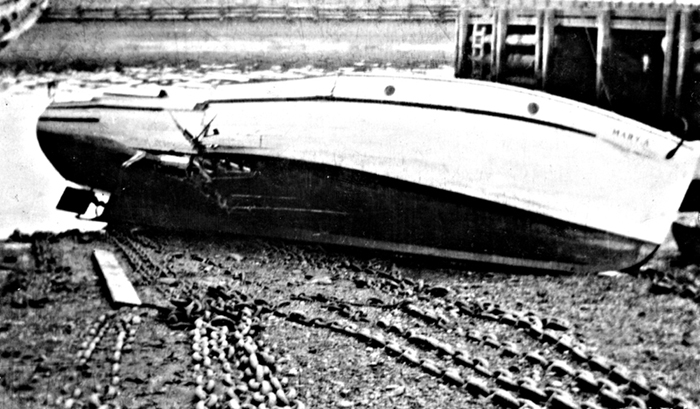

Jach do you remember the Mary A. shown in the attached photograph? And what are those large chains?
Kerr
Jack’s reply
The Mary A was built by my father's crew for Otto Hatfield around 1935 and
named after his youngest daughter Mary Ada Hatfield who is married to Cedric
Trefry and lives in Port Greville. Otto used it as a family boat mainly
when the whole clan would go to Fisherman's Cove for a few days and stay in
a cabin that was owned by Otto (the second cabin at the Cove was owned by
Ansley Hatfield - - both are gone now and the last time that I
visited the Cove another cabin was situated there). Also, Otto would use
the Mary A as a small tow boat when it was required to tow a scow a short
distance.
Somewhere around 1938, the Rio Casma backed into the Mary A resulting in the
damage that you view in the pictures. I assume that an Insurance firm paid
for a new and bigger boat being built - - also called the Mary A, as I
recall. I do not know the final destination of the boat as I was away from
Port Greville when it seemed to leave the community. Mary may know.
The chains: These were from the Elderkin Rafts of the early 1900's and
purchased by my father. I assume that he used them as a form of brake when
launching vessels between 1916 and 1920 then by the Wagstaff & Hatfield
Shipyard firm. A portion of one of these chains is located at the front
of the parking lot at the Age-of-Sail Museum in Port Greville. Method of
use: They would be placed in the bed of the river and attached (via a rope)
to the stem of the vessel to be launched. During the launching, the rope
would be hauled aboard the vessel and as it reached the end of the launch
ways, the rope would be made fast resulting in the vessel dragging the
chains thus slowing the motion of the vessel until it stopped finally. The
trick was to make the rope fast at the proper time in order to get the
greatest advantage of the braking action of the dragging chains. Harvey
Merriam was always given this task until he missed a few times resulting in
the vessel moving up river -- in fact, one of the minesweepers ( out of
control as Harvey failed to make the rope fast ) rammed the storage building
located on the Government Wharf. Not always would the launching motion be
fast, therefore, Harvey's task was rather easy until they began using axle
grease in place of tallow. After this change, we saw fast launches and the
person had to be alert and quick in getting the rope made fast at the
optimum time -- this was when Harvey was gradually replaced.
Jack
Even the shipyard owner, the person who designed and oversaw the building of the vessel to be launched, sometimes endured unsuccessful launchings. George Wagstaff, Jack Wagstaff’s father, had one such experience. Jack said that it was probably the most embarrassing moment of his father’s life. The vessel “stuck on the ways”. The link below shows the situation. Fortunately the schooner floated free when the tide came in.
Stuck on the ways.
The schooner Ladysmith was built in an elevated field, a field separated from the beach and high tide by a high bank. This building site required an exceptionally long launch way. When the Ladysmith slid down these ways she accelerated to a speed that ignited the tallow on the ways. The story is told that each section of the ways burst into flame as the Ladysmith passed by. Fortunately the schooner reached high water and floated free. The ways, however, burned! The link below shows the Ladysmith under construction. The Ladysmith